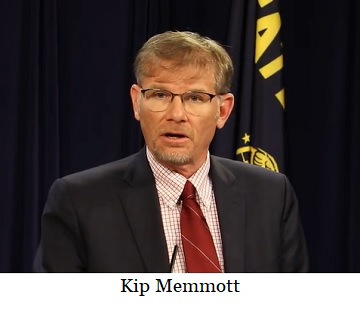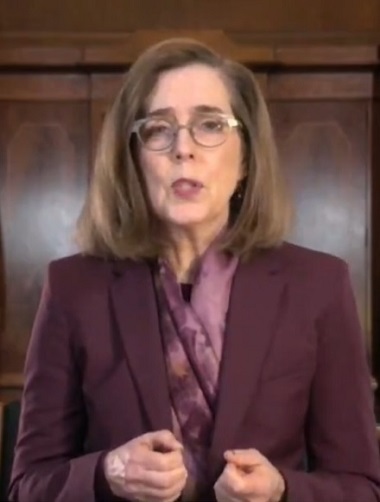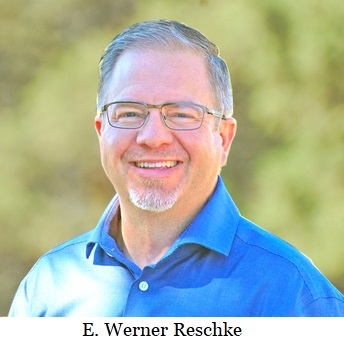 Post an Event
Post an Event
| Benton County Republicans’ Private Fundraising Event, “Bent-on Boots and Bling” with Trey Taylor |
| Friday, September 5, 2025 at 5:00 pm |
| Featuring Trey Taylor
Music Private Event
Friday, September 5, 2025 5:00-5:30 pm VIP Reception
5:30-8:00 pm Heavy Appetizers,
Auction, Concert
Red: $750 VIP Reception
Front Row Table Sponsor
White: $500 Table Sponsor
Blue: $50 per person
Limited Seating. Get Yours Now!!!
Support Local
Dress up: Bling, Cowboy, Patriotic Benton County Republican
FUNDRAISER
www.BentonGOP.org
Get your tickets today at:
https://www.bentongop.org/event-details/benton-county-republicans-fundraiser/form
About Trey:
Trey is the youngest African American Man in Country Music History. The Denver Post wrote
"It's impossible to miss his enthusiasm. With a fondness for cowboy boots, gaudy colors and dazzling jewelry, Trey Taylor could stand toe to toe with any of the Pop, Country or even Rap
contemporaries of his generation.“ |
| Trysting Tree Golf Club, 34028 NE Electric Rd., Corvallis |
A lesson in civics
For most bills passed in the Oregon Legislature, a simple majority -- 50% plus one -- is required in both houses, plus the signature of the governor for the bill to become law. There are 60 House seats and 30 Senate seats, so the math is pretty simple on this one. One thing to note is that if there is an absence or vacancy, that doesn't reduce the number of yes votes needed to pass a piece of legislation. This is laid out in Article IV Section 25 (1) of the Oregon Constitution says "a majority of all the members elected to each House shall be necessary to pass every bill or Joint resolution."
The President of the United States has a "pocket veto," meaning that if he "pockets" an act of Congress and doesn't sign it after 10 days, the bill is effectively vetoed. Article 1 Section 7 of the US Constitution says
If any Bill shall not be returned by the President within ten days (Sundays excepted) after it shall have been presented to him, the same shall be a Law, in like manner as if he had signed it, unless the Congress by their Adjournment prevent its return, in which case it shall not be a Law.
Oregon is different. Oregon has a "pocket signature," so to speak, except up to 30 days after the end of a session.
Article V Section 15b (3) If any bill shall not be returned by the Governor within five days (Saturdays and Sundays excepted) after it shall have been presented to the Governor, it shall be a law without signature, unless the general adjournment shall prevent its return, in which case it shall be a law, unless the Governor within thirty days next after the adjournment (Saturdays and Sundays excepted) shall file such bill, with written objections thereto, in the office of the Secretary of State, who shall lay the same before the Legislative Assembly at its next session in like manner as if it had been returned by the Governor.
There is an even lower threshold than the simple majority. Resolutions passed by both chambers creating ballot measures to amend the Oregon Constitution need only a simple majority of both chambers and
do not need the governor's signature Additionally, Article V of the US Constitution provides for actions of state legislatures. In these cases, the signature of the Governor is not required.
The Congress, whenever two thirds of both Houses shall deem it necessary, shall propose Amendments to this Constitution, or, on the Application of the Legislatures of two thirds of the several States, shall call a Convention for proposing Amendments, which, in either Case, shall be valid to all Intents and Purposes, as Part of this Constitution, when ratified by the Legislatures of three fourths of the several States, or by Conventions in three fourths thereof, as the one or the other Mode of Ratification may be proposed by the Congress; Provided that no Amendment which may be made prior to the Year One thousand eight hundred and eight shall in any Manner affect the first and fourth Clauses in the Ninth Section of the first Article; and that no State, without its Consent, shall be deprived of its equal Suffrage in the Senate.
There are two types of legislation that require super-majorities.
In November of 1996, Oregonians voted to amend the constitution by a vote of 52.3% to 47.7% to require a 3/5 majority to raise taxes. That means 36 yes votes in the House and 18 votes in the Senate. Article IV Section 25 (2) says, "Three-fifths of all members elected to each House shall be necessary to pass bills for raising revenue." Sometimes there is a dispute over what exactly a tax is, and, in the end this will be resolved by the courts.
When Oregon voters passed Measure 11 in 1994 requiring mandatory sentences for certain felonies, by a margin of 65.6% to 34.4%, they set in the Oregon Constitution a requirement that in order for the legislature to change any of these requirements, they must have a 2/3 vote or 40 votes in the House and 20 votes in the Senate. It reads, thus,
Article IV Section 33. Reduction of criminal sentences approved by initiative or referendum process. Notwithstanding the provisions of section 25 of this Article, a two-thirds vote of all the members elected to each house shall be necessary to pass a bill that reduces a criminal sentence approved by the people under section 1 of this Article.
All this is for naught if either one of the chambers is unable to call together a quorum. A two-thirds majority is also needed just to do business:
Article IV Section 12. Quorum; failure to effect organization. Two thirds of each house shall constitute a quorum to do business, but a smaller number may meet; adjourn from day to day, and compel the attendance of absent members. A quorum being in attendance, if either house fail to effect an organization within the first five days thereafter, the members of the house so failing shall be entitled to no compensation from the end of the said five days until an organization shall have been effected.
These are important thresholds to know to understand the balance of power in the legislature.
--Staff Reports| Post Date: 2020-11-27 07:23:14 | Last Update: 2020-11-29 19:24:40 |
Thousands of dollars of damage in Hawthorne district
On Thanksgiving morning November 26, 2020, at about 1:22 a.m., Portland Police responded to reports of people breaking windows and spraying graffiti on the New Seasons Market in the 4000 block of Southeast Hawthorne Boulevard. Multiple callers reported seeing a group of people, dressed in black clothing, moving west along Southeast Hawthorne breaking out windows as they went.
Police arrived and found a group near Southeast 37th Avenue and Southeast Harrison Street matching the description and carrying evidence connecting them to the vandalism.
Officers canvassed the neighborhood, spoke to witnesses, and found damage to at least ten businesses between Southeast 41st Avenue and Southeast 33rd Avenue along Southeast Hawthorne Street, in both the Sunnyside and Richmond neighborhoods. Some of the damage was sufficient to provide access to the interior of retail stores so officers contacted responsible parties and stood by while contractors or employees boarded up windows. Grocery stores, banks, an auto service center, a package distribution and mailing center, and local business storefronts were damaged.
Officers arrested three adults who were booked into the Multnomah County jail:
- 24-year-old Chester Hester, ten counts of Criminal Mischief I.
- 38-year-old Nicole Noriega, ten counts of Criminal Mischief I.
- 23-year-old Bailey Willack, ten counts of Criminal Mischief I.
Officers found one adult in possession of a semi-automatic pistol. That person was referred out of custody to the district attorney's office for potential weapons charges. One juvenile was detained and referred to the court for crimes related to property damage.
Based on witness statements, it is likely that more people were involved in these crimes and police will try to determine their identity through further investigation.
--Ben Fisher| Post Date: 2020-11-26 15:18:27 | Last Update: 2020-11-28 16:24:11 |
Allowed discrimination and hazing to go on
Editor's note: This article contains language that some readers may find offensive. Reader discretion is advised.
The Lake Oswego School District is being sued for what appears to be racially motivated harassment of a student by their classmates. The lawsuit not only implicates the school district, but State Senator Rob Wagner, who is the Chair of the Lake Oswego School District School Board.
In a letter dated February 18, 2020, Lake Oswego School District Superintendent Lora De La Cruz was notified by Kevin C. Brague, an attorney with the Brague law firm, describing the racially motivated behavior by the students, the lack of action by the school district, and threatening a lawsuit.
As you may be aware,  has been the subject of hazing, harassment, and racist attacks at Lakeridge High School.
has been the subject of hazing, harassment, and racist attacks at Lakeridge High School.  plays on the junior varsity team. Her teammates have their
own social media accounts in which they ridicule, haze, and harass
plays on the junior varsity team. Her teammates have their
own social media accounts in which they ridicule, haze, and harass  . These teammates ostracize
. These teammates ostracize  . They have taken
. They have taken  photograph from games and edited into other photos where it appears that
photograph from games and edited into other photos where it appears that  is being harmed. These teammates have targeted to such a degree that is ostracized throughout campus and the school day.
is being harmed. These teammates have targeted to such a degree that is ostracized throughout campus and the school day.
The current hazing and harassment resurfaced in January 2020. One school year prior, Principal Desiree Fisher received a complaint from  concerning similar hazing/harassing conduct. Principal Fisher did nothing to address this earlier complaint, which endorsed and condoned a hostile education environment. It was foreseeable that one term later, the same hazing and harassing conduct continued.
concerning similar hazing/harassing conduct. Principal Fisher did nothing to address this earlier complaint, which endorsed and condoned a hostile education environment. It was foreseeable that one term later, the same hazing and harassing conduct continued.
Lakeridge’s Principal Desiree Fisher, Vice Principal Noah Hurd, and Athletic Director Nathan Stanley have failed to address the students’ self-labeled “Caucasian Invasion†at Lakeridge High School. This is the term the girls’  program uses in hazing and harassing
program uses in hazing and harassing  .
.
Clearly, the message from Lakeridge is to apologize to the perpetrators of hazing, harassment, and racism for the inconvenience of the farce of an inquiry, and then direct the target of hazing, harassment, and racism to shut up.
 has begun self-injurious behavior as a result of the hazing, harassment, racism, negligence, and deliberate indifference endorsed and condoned by LOSD at Lakeridge High School.
has begun self-injurious behavior as a result of the hazing, harassment, racism, negligence, and deliberate indifference endorsed and condoned by LOSD at Lakeridge High School.
A claim for damages will be asserted against LOSD.
In a more recent
letter to Rob Wagner, Attorney Michael Fuller from the law firm representing the student, writes:
By failing to act reasonably to settle this claim on your behalf, the insurance adjuster for the school district may not have acted in your best interest.
If you are interested in attending a second mediation with Mr. Jones in hopes of resolving this dispute please let us know. It may be possible to resolve these claims against you personally without paying any money and by agreeing to cooperate as a witness and by assigning any claims you may have against the school district and its insurance adjuster to Mr. Jones.
In a press release, Kim Sordyl, an attorney representing the student recounts many alleged incidents of racism in Lake Oswego School District, including,
“Lake No Negro,†“fucking nigger,†“frizzy hair,†“nigger dogâ€. These are just some of the popular racist slurs used in Lake Oswego Schools. Swastikas decorate desks. Last year, the girls Varsity basketball team proudly re-branded themselves the “Caucasian Invasion.†White students chant “you can’t read†to a Black athlete. A Black athlete was called a dog and punched in the face by his white coach. When students speak up, they are harassed by peers and staff, called a “narc†and a “snitch,†and get cyberbullied. Those familiar with the pervasive racist culture in certain Oregon schools understand that such treatment can lead to suicide.
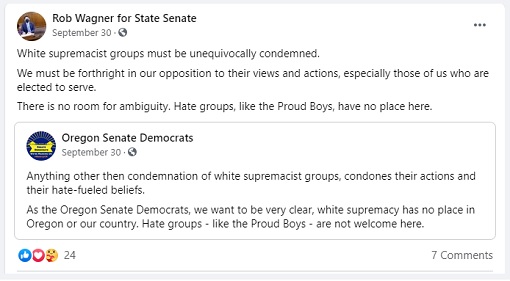
"Immediately upon moving to Lake Oswego, Student X was consistently victimized. They were razed about “frizzy hair,†which made its way into a meme by their own teammates. They were cyberbullied, had photos of the, taken without their consent, called “nigger†and told to “sit in the dog crate.â€
"In another gripping episode, all-white, all-male officials, including Assistant Principal Noah Hurd, called Student X into the office without notifying Student X’s parent. Student X was terrified. Student X broke down crying. Hurd directed Student X not to talk about the race discrimination to anyone, and warned there would be consequences if they did, saying, “It’s not safe to talk about it.†Student X was later told, “you’re gonna pay for this.â€
Wagner told
Willamette Week, "I don't know the context behind the suit." Apparently, this is not true. According to Sordyl, "In September, he received a 28 page letter regarding the facts and claims. At least 2 single spaced pages related to
his actions. For example, after the student sent a complaint of race discrimination to her principal, the principal recommended that the student leave the district. Rob Wagner voted to have the student leave the district. Rob Wagner has an attorney representing him and the district. It's late November and he still doesn't know the context behind the suit?"
Senator Wagner has been vocal about his opposition to "white supremacy" and this incident and his lack of attention to this in an appropriate way, makes his previous statements seem hollow. Other leaders in the district -- including Wagner -- supported pushing the student out of the district.
Shortly after the death of George Floyd, Lake Oswego School District Superintendent sent an email to the community saying
"The ripples of pain and anguish that result from ongoing systemic racism do indeed impact each and every one of us. In LOSD, we are committed to actively contributing to the healing and repair that is desperately needed in response to systemic racism. We strive to be a safe and inclusive community, to disrupt racism, and to support our community of color and all members of our community. We know that the fight against racism, oppression and hate cannot fall by default on our community members of color. We must lead it together. Our district efforts, centered on the LOSD Equity Policy, include intentional efforts of the School Board, our district and school leaders, the Diversity, Equity and Inclusion Advisory Committee, and staff and student leaders who are squarely focused on eradicating racism and inequities in our community. We are committed to our efforts to enact anti-racism and social justice in our schools, and to supporting the unique needs of our students of color, including our Black and African American students, as the too frequent victims of racism and racist acts."
Gratefully, we can report that the student is now taking junior and senior year at once, during distance learning, and working 20 hours a week. She is getting straight As.
--Staff Reports| Post Date: 2020-11-26 12:52:49 | Last Update: 2020-11-28 16:24:32 |
The future of city growth
Deep in the bowels of the Stalinist-era Department of Administrative Services building is housed the Oregon Office of Economic Analysis. They report directly to the Governor. In a recent analysis released early November, Josh Lehner of OOEA describes an eerie transition of employees being recalled to the office, and what that means for downtown areas.
Working it backwards, Lehner's conclusion is quite possibly the most interesting aspect of this analysis, stating "To the extent there are larger, permanent changes, it provides opportunities to repurpose existing spaces to meet whatever that future demand is."
What future demands are we talking about exactly? According to Lehner's analysis the rate of employees working from home is beginning to drop, as employees are called back to the office, which is changing how and where individuals spend money. When employees are telecommuting from home, they tend to spend money in suburban areas closer to home. Conversely, daytime revenue for downtown restaurants and business have taken a big hit.
As employees begin to trickle back into the offices of densely populated urban areas, Lehner suggests the rates, even when coupled with destination demands, is not enough to save the current businesses in these downtown areas. But Lehner is also quick to point out that as noted by City Observatory -- a website and think tank devoted to data-driven analysis of cities and the policies that shape them, "there are a lot of reasons to be optimistic about cities". Now we're getting to the quick of it. City Observatory claims that cities will quickly become the booming epicenter in this post pandemic world, rising yet again. In the linked City Observatory prediction authored by Joe Cortright, who previously served 12 years as the Executive Officer of Oregon Legislature’s Trade and Economic Development Committee. He now writes for the City Observatory. He says, "To hear many tell it, cities are either doomed or in for a prodigious reset."

Cortright outlines his prediction through what he dubs as the "7C's", Competition, Consumption, Couples, Careers, Creativity, Camaraderie, Commitment, and Civic Commons. "Those who work in the office will be better connected to the business, in the stream of more information; they’ll also be seen as having more commitment, and be able to discern the subtle cues (and bolster the in-person relationships) that privilege them over other workers. In short, those who work at a distance will be less competitive for pay, promotions, responsibility, and opportunity." Plainly stated those who aren't capable of working in person, will be left behind and suffer dramatic wage losses. In this new economic model of a post pandemic world, skill is not as important, as who is able to show up.
"For a time, a worker or organization can take all of its established routines and do them at a distance." Claims Cortright. However, "Organizations that depend exclusively on remote work will likely find themselves to be less nimble and competitive than those who can more quickly build effective teams with face-to-face interaction."
Cortright also weaves in and stresses the importance of government affairs, or civics, quoting Bernie Agrons, “The world is run by those who show up.†"Being there matters". "And in recent months, city parks, squares and streets have been the place where we have assembled to seek redress of our grievances and to declare that Black Lives Matter. Even as we had to social distance and wear masks, we gathered together in the urban public realm to make our voices heard; we didn’t (and couldn’t) do so simply by clicking like on a Tweet or a Facebook post."
Cortright ends his push for city resurgence and reset with this summation, "cities are emblematic of more than a grudging willingness to live together. Rather, they are perhaps the greatest human achievement and the manifestation of how we are most truly human, together. It’s time to stop regarding cities as consolation prizes and recognize them as the prize."
How do we end this pandemic and get back to in person interactions? According to policy released from the Oregon Health Authority, phase three will happen once the vaccine, or reliable treatment for COVID-19 is available. The FDA has approved a treatment for COVID-19, yet Oregon remains oscillating between phase 1 and 2. The vaccine, reliable or not, will be released at the end of January for wide spread distribution.
In short, cities are failing under current lockdown restrictions, but after a great reset, and vaccine requirements are put into place, cities are slated to become the new epicenter, and "being there matters". In our post pandemic world, everything from financial survival, career building, to redress of grievances, will need in person interaction for success.
The lingering question, what is the price of success in this new order of things?
--Breeauna Sagdal| Post Date: 2020-11-26 07:10:35 | Last Update: 2020-11-28 16:24:51 |
Science is still a thing, isn’t it?
Masks and social distancing while in public, such as when at your local grocery store, is a
must to prevent you and others from getting and spreading the COVID-19 virus right? That’s the wisdom from the authorities and of course the authorities know best because they are informed by the experts.
Some have rejected this saying, “I’m healthy. I’m not worried about catching this virus. My immune system is strong, I am young, and will fight it off, if I do catch it. And if I do catch it, I’ll stay at home until I get over it, like I do with a cold or the flu.†But the experts tell us that masking and social distancing isn’t necessarily for your health but for the health of others. You see you might have COVID-19 virus and not even know it. That is what the experts call an “asymptomatic†case — someone who has contracted the virus and can spread the disease yet not does have any symptoms.
Therefore, according to the experts and authorities, mask wearing and social distancing in public is to prevent people who unknowingly may be asymptomatic with the coronavirus from spreading it to others. Sounds good, right? Wrong.
Let me ask you, do you love your family? Do you care about those you live with? If yes, then you must also be wearing your mask at home and social distancing as well right? You’re not? Aren’t you worried that you might be an asymptomatic carrier, or worse, they might be and spread the virus to you? How is it you know at home you are not an asymptomatic carrier and don’t wear your mask or social distance, but when in public you don’t know so you wear a mask and social distance? Does that knowledge just disappear when you get in your car and drive to the grocery store, but then you remember when you get home and take off your mask and ignore social distancing with your family?
Matter of fact, the home is the best place to test whether anyone has COVID-19, because if they did, and if it is as contagious as the experts tell us, everyone one in your house would’ve had it by now.
We need to think carefully about always obeying orders from the authorities just because they are the authorities. This is especially true when the authority for the state of Oregon has been consolidated into one person, the Governor. It is dangerous to go against one's conscience, so if you think you need a mask and social distancing in public, by all means do what you think keeps you safe and well. But let’s not allow authorities rule our lives just because they are authorities. We have all been given a mind to think through decisions like this. Matter of fact we spend everyday making important decisions about all sorts of things that benefit us, and by extension those around us.
What I ask from the experts and authorities is to give us the best information about the coronavirus, and then we the people of Oregon will do what is best. That is what is called liberty.
Happy Thanksgiving, from all of us at the Northwest Observer
--Northwest Observer Editorial Staff| Post Date: 2020-11-25 18:03:32 | Last Update: 2020-11-28 16:26:00 |
Opinions differ on what the recovery looks like and how to boost it.
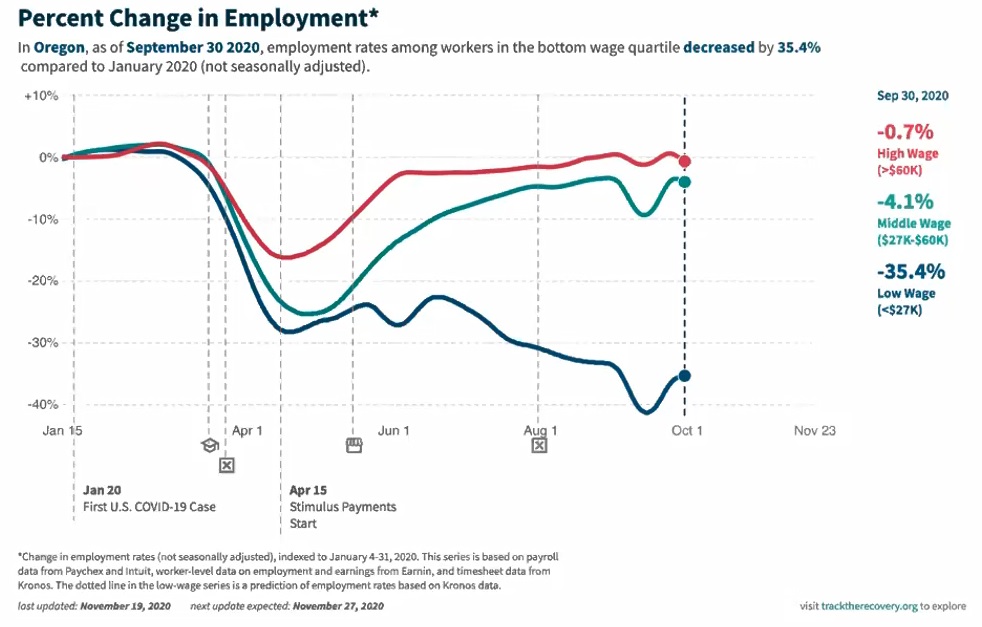
In an
open session of the Governor's Council of Economic Advisors, the Council addressed questions put to it by Governor.
Joe Cortright, chair of the Council, described what he called a "K-shaped" recession in which employment in non-service and non-retail positions rebounded faster than service and retail sectors. In a similar point, he said that economists were seeing a decline in services consumption, not a decline in capital spending on large ticket durable goods during the outbreak. He credits the social safety net for keeping the recession from being far worse, and predicted an eventual recovery.
Another council economist took issue, saying, "It's not when the economy recovers, it's when the restrictions are lifted, then the economy will recover It's not like we're waiting for people to have more money to go out for dinner."
One opinion of the path to recovery, didn't offer much hope to small businesses
They're going to come back more when we finally get a credible vaccine that's going to allow people to come back and allow you to raise those restrictions out. The restaurants haven't been wiped out. The stoves are still there the plates are there, the knives the forks, the chairs and they can re-open and these people can fill back into those jobs. It's not like those places have been wiped out completely, What we may see is we may see ownership changes at restaurants and the previous owners aren't able to handle the debts and so on that have occurred and other people will step in to take their place. We'll have a redistribution, in a a sense, of ownership.
This view was countered by another economist who countered,
These restaurants and bars and the leisure and hospitality business -- especially those that are independently owned -- and small business are the ones that are hit hardest and we can see from the data that 25% of small businesses have closed in Oregon. And it doesn't feel that it's going to be a temporary problem -- that all of these are going to bounce back. A lot of our tourism business is based on having all this talent in the restaurants and leisure providing businesses, and there needs to be some kind of mechanism, not just to provide them with some money to maybe tide them over and not shut down, but how do we help them generate additional revenue that keeps them going and not close down permanently after everything comes back online.
A D V E R T I S E M E N T
A D V E R T I S E M E N T
Governor Brown asked the council, "A federal study took a look at rental arrears in Oregon and calculated that we are looking at $250-300 million I don't know if we'd borrow it or whatever, but does that make sense for the short term for the state to step up and pay that." After a long silence, and one speculation that federal help might step in, one economist offered, "I don't know that it's possible for the state to make that investment -- that it just might be too big. I would probably let the bankruptcy courts deal with it and let the banks deal with it. There's going to be costs that just can't be dealt with effectively by this state."
The council considered the impact of more stimulus -- an expensive remedy. Cortright spoke on the possible impact.
"The reason it isn't working as well as we would like is we made consumers whole in the second quarter, basically. Income in the US was higher in the second quarter even though we had this big pandemic. So people have lots of money in their hands. People were unwilling -- or unable -- and it's a combination of the two to spend it in the industries where people were laid off. So, we have lots of money and we could all go to the restaurants and we could all buy food
if we could go to the restaurants. So throwing more stimulus right now in a era in where we can't actually go to those businesses, doesn't re-hire those people."
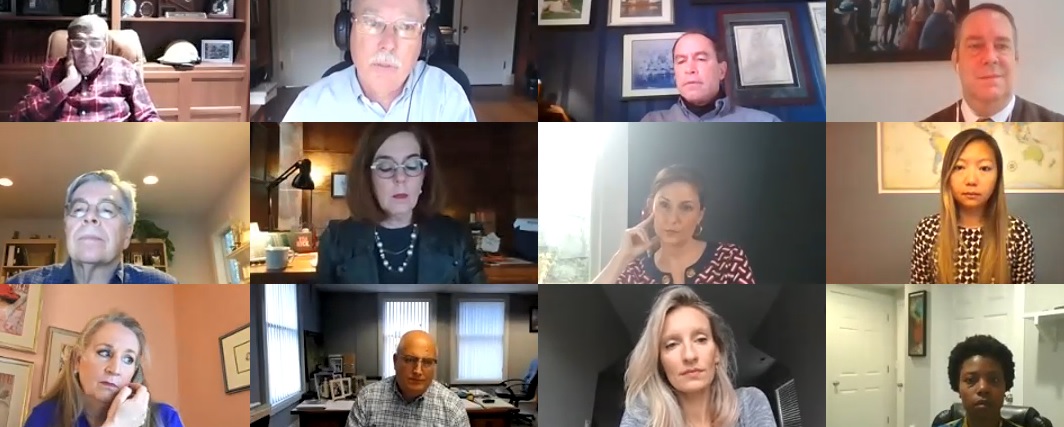 --Staff Reports
--Staff Reports| Post Date: 2020-11-25 16:29:25 | Last Update: 2020-11-25 19:10:35 |
PEBB’s reserves have grown more than anticipated over the years
Secretary of State Bev Clarno and Audit Division Director Kip Memmott released an
audit of cost containment practices for state worker’s health care. What should be concerning to taxpayers is six paragraphs on page 14 entitled, “PEBB’s reserve needs better planning and legislative sweeps have reduced the balance.†The PEBB’s reserve balance was significantly reduced by a $135 million legislative sweep, triggering a $14.5 million federal penalty. The audit criticizes the board for not having a strategic plan for how to adjust and use reserve funds when the reserve accumulates more than needed to address claims and other program costs.
PEBB began moving toward self-funded plans in 2006 to better control premium cost increases and help save money, and has been mostly self-funded since 2010. As self-funded, PEBB pays for employees’ health benefits with its own funds (collected from premiums) and assumes direct risk for paying benefit claims, with any moneys remaining saved in reserve. The PEBB board, based on consultant recommendations, sets the premium rates, which includes a calculation for the reserve.
PEBB’s reserves have grown more than anticipated over the years. Rather than using some of the reserve to lower premiums, or other allowable services to reduce benefit plan costs, the reserve continued to grow for multiple years. PEBB’s reserve was reduced significantly by the Legislature when it was used to help balance the state’s budget. The Legislature swept $120 million from PEBB’s nearly $435 million reserve in Spring 2017 and is set to take another $15 million in 2021. As a result, PEBB was fined $12 million for the first sweep from the federal government. The Office of Management and Budget’s A-87 Circular requires that allocating the cost of plans to agencies be done on a consistent basis and there should be an equitable distribution of costs based on benefits received. The legislative sweep violated those required cost principles. Likewise, the program is expected to be fined $2.5 million from the second sweep in 2022.
Taking a sweep of $147.5 million to shore-up the state budget at a 10% cost lacks fiduciary responsibility. By PEBB’s own Administrative Rules, this is not an option for use. According to OAR 101-001-0015, PEBB may use its reserves for the four following purposes:
- reimburse insurers for contracts payments (e.g., if benefit expenses exceed premium revenues)
- minimize premium increases and the impact on premium contributions due to benefit plan changes
- pay for expenses critical to PEBB program administration (e.g., data processing)
- pay for services, programs, or studies that will reduce benefit plan costs
In accordance with state statute, the board has opted to use some reserves to help pay for program costs such as program incentives (e.g., the Health Engagement Model) and taxes (state tax on commercial health insurance plans). Reserve funds have also been used to align tiers, such as employee and family, within each medical plan so the program would avoid a tax penalty. Recently, in June 2020, the board used some reserve funds to buy-down premiums to help with agencies’ budgets in addressing forecasted budget concerns and economic uncertainties of the COVID-19 pandemic.
A D V E R T I S E M E N T
A D V E R T I S E M E N T
However, as the audit points out, the board does not have a formal policy or strategic plan for determining the appropriate reserve amount to be maintained or for the steps to take when the reserve reaches higher or lower than targeted levels. Having a policy or plan could help ensure reserve funds are more effectively used toward containing plan costs.
--Donna Bleiler| Post Date: 2020-11-25 15:36:06 | Last Update: 2020-11-25 15:44:32 |
And you thought it was only going to be two weeks.
In a press conference today, Oregon Governor Kate Brown described a policy that will include continuation of lockdown measures past the two-week duration previously announced. She issued a stern warning. "Irresponsible behavior over Thanksgiving, at best will only make the pandemic last longer. At worst, it will send one of your loved ones to the ICU."
She said that there would be
four levels of county risk, not unlike the "phases" used earlier in the outbreak. Describing a continued lockdown, she said,
"The statewide two week freeze is complete next week. However, due to extensive COVID-19 spread in our communities, there are at least 21 counties including our most populous counties like Multnomah that are facing extreme risk of virus spread and will need to continue with strict health and safety measures similar to the freeze through most of December. My hope is that Oregonians in these counties take this news seriously and commit to hunkering down for the next several weeks. For all counties in Oregon we are introducing a data-driven framework intended to protect Oregonians, by putting appropriate safety measures in place dependent on a county's risk to the disease ranging from low risk to extreme risk. It's important to know here that there is not a no-risk category."
Hopes were buoyed by Oregon Health Authority Director Pat Allen looking forward to the development of a vaccine and the expectation that 30,000 doses of the vaccine would ship to Oregon in December -- top be prioritized among the over 200,000 health care workers in Oregon.
These protections are not forever. In December Oregon expects to begin receiving limited shipments of the first COVID vaccine. While we're sill awaiting federal emergency use authorization, these vaccines appear to be safe and effective. That's good news. If we all get vaccinated, we can put and end to this pandemic.
The new policies include a relaxation of the prohibition on outdoor dining which will be allowed in structures that have at least three sides open. The Governor said that she hopes to roll into the new metrics next week.
A D V E R T I S E M E N T
A D V E R T I S E M E N T
The entire list of counties at risk is
Lower Risk: (5)
- Gilliam
- Sherman
- Tillamook
- Wallowa
- Wheeler
Moderate Risk (4)
- Curry
- Harney
- Lincoln
- Morrow
High Risk (6)
- Clatsop
- Coos
- Crook
- Lake
- Hood River
- Josephine
Extreme Risk (21)
- Baker
- Benton
- Clackamas
- Columbia
- Deschutes
- Douglas
- Grant
- Jackson
- Jefferson
- Klamath
- Lane
- Linn
- Malheur
- Marion
- Multnomah
- Polk
- Umatilla
- Union
- Wasco
- Washington
- Yamhill
--Staff Reports| Post Date: 2020-11-25 13:39:31 | Last Update: 2020-11-25 16:14:11 |
Enforcement of victimless crimes creates additional problems
Critics of modern American policing standards are now putting their money where their mouth is. There is now an advocacy group called the Thick Red Line that is working for change by ending enforcement of victimless crimes. Victimless crimes are not really crimes. They are where politicians and bureaucrats use the police in an attempt to legislate morality or raise revenue on the population.
Introducing The
Thick Red Line, a policy project whose team includes former sheriff Richard Mack and others. Their work highlights how oftentimes it is out of touch politicians and bureaucrats who are creating laws that the rest of the community must then live with. Including peace officers who are then asked to enforce those mandates and laws among the people. Scrutiny and elimination of these unnecessary and victimless crimes might be the key to reducing police violence in communities. A real crime, by definition, has a perpetrator and a victim: murder, assault, rape, theft, and extortion are all obvious crimes because there is a victim.
When police are busting thieves, murderers and rapists then everyone loves the police. It is the enforcement of victimless crimes and raising revenue on the population that is causing racial and societal division. End those policies and the violence stops and people will once again respect the police.
A D V E R T I S E M E N T
A D V E R T I S E M E N T
Drug possession, gambling, and making arrests for ignoring Covid-19 lock down and social distancing orders are examples of victimless crimes where politicians attempt to get police to use violence immorally and preemptively on overwhelmingly peaceful people frequently to raise revenue or enforce their version of morality on a population.
The
Thick Red Line project is an effort to restore respect for law enforcement by abolishing victimless crime. They are concerned for the safety of both the police and the public in the wake of the George Floyd riots. They believe they have a solution that safeguards both and dramatically reduces the amount of violence in society while reducing costs to the tax payer, dramatically reduces the prison population, and frees up the police to focus on real crime.
Their
website provides the following information:
Victimless Crimes are Not Really Crimes… And Make the Cops the Criminals
To restore the trust and faith in the police, we are suggesting that individual Sheriffs, police chiefs, deputies, police officers and elected officials organize their colleagues and agencies through their union and/or collectively without the union into an agency-wide refusal to enforce any law or regulation that doesn’t have a real victim. This would:
dramatically reduce the violence in society committed by the police and instantly reduce the racial and societal division it causes
reduce the influence of organized crime by getting rid of drug, gambling and prostitution markets
save taxpayers billions in apprehension, court costs, incarceration expenses, and lawsuits related to excessive violence and unintended deaths dramatically reduce the almost 500,000 people incarcerated for victimless crimes who are frequently forced to work as slave labor in for-profit prisons.
The Solution – Organize Collectively and Refuse to Enforce
Because politicians are attempting to force the police into more tyrannical policies including stealth gun confiscation under "red flag laws", bankrupt local businesses with lockdown orders based on suspicious "science", and are now talking openly about using the police for mandatory vaccinations, honest Sheriffs and police are going to have to draw a THICKREDLINE in the sand. We are helping them understand where that line needs to be drawn logically and morally in the 1000+ year natural law tradition.
The Thick Red Line Pledge – Draft below:
The officers of this department recognize natural law and understand that it is morally and logically impossible for the government or our badge to confer rights upon us that the population does not have and cannot delegate.
We pledge to only act to protect lives, liberty and property.
We renounce the use of violence on peaceful people and refuse to enforce:
- Victimless crimes including prohibitions on sales of substances or services between consenting adults, gambling, mandated masks, possession of firearms, accidentless “speeding†or other victimless traffic infractions.
- Mandated medical interventions including forced vaccination, mandated social distancing, or closure of businesses based on alleged public health issues.
- Seizure of money or property through asset forfeiture.
- Mandated tax stickers, emissions testing, insurance regulations and other government-revenue collection where the government doesn’t have a willing counter-party.
--Ben Fisher| Post Date: 2020-11-25 09:41:14 | Last Update: 2020-11-25 17:50:02 |
Constitutional requirements not met
Oregon’s Speaker of the House has asked the Governor to consider calling a special session in December using a never-used Oregon constitutional provision: Article X-A. This provision was written and amended to provide for a functioning state government given a catastrophic disaster like a massive earthquake, war, tsunami, etc. The requirements to declare an Article X-A are extremely high, because of the many constitutional provisions Article X-A bypasses, in order to respond to the catastrophic disaster.
It’s important to note: Government actions or inactions, and the fall out from those decisions, should not be considered a qualifier to declaring an Article X-A catastrophic disaster.
The definition and requirements for such an extraordinary declaration is found in Section 1 (a) and (b) of Article X-A of the Oregon Constitution. One of four items from 1 (a) must be true and then one of the four elements in 1 (b) must also be true. Following is the text.
Section 1. Definitions; declaration of catastrophic disaster; convening of Legislative Assembly. (1)
As used in this Article, "catastrophic disaster" means a natural or human-caused event that:
(a) Results in extraordinary levels of death, injury, property damage or disruption of daily life in this
state; and
(b) Severely affects the population, infrastructure, environment, economy or government functioning
of this state.
My focus is on 1 (a) because I believe none of these requirements are true as of today. Conditions may change in the future, but as of now Article X-A may not be used by the Governor.
The word “extraordinary,†which is listed in the first requirement, must be applied to the following three conditions, otherwise ANY injury, or ANY property damage would qualify. This is a catastrophic disaster declaration, meaning the bar is extremely high for any one of the four conditions to be met, otherwise they would be, not extraordinary, but ordinary.
1. Results in extraordinary levels of death
Oregon Health Authority (OHA) data shows this not to be the case. Assuming a linear trend from the first 10 months of 2020, mortality rates in Oregon this year may actually be lower than previous years. This requirement is not met.
2. (Extraordinary) Injury
While few Oregonians have been hospitalized, even fewer have died directly due to SARS-CoV-2. A virus with the survival rate of over 99% does not constitute extraordinary injury, especially considering how little of the population have tested positive. Furthermore, over half of those who have died related to the virus in Oregon were over the age of 80, and many of those who have tested positive for the virus are asymptomatic or have mild symptoms. This requirement is not met.
A D V E R T I S E M E N T
A D V E R T I S E M E N T
3. (Extraordinary) Property damage
The only extraordinary property damage done during the past eight months is due to riots in Portland and the unwillingness by political leaders to stop them. Inaction by political leaders should not qualify as a means to calling a special session under this Article. Otherwise, the government could use this tactic with any protest that causes property damage in order to enact this constitutional provision. This requirement is not met.
4. (Extraordinary) disruption of daily life in this state
The only thing extraordinary about Oregonian lives this past year has been state government’s reaction to the virus. The virus, by itself, has not caused extraordinary disruption to daily life for a majority of Oregonians. What has caused an extraordinary disruption are executive orders closing businesses, schools and other draconian mandates. Government actions should not be
considered a qualifier to declaring an Article X-A catastrophic disaster. Otherwise government, which has the power, can cause extraordinary disruption to daily life anytime it believes such a declaration is in its self interest. This requirement is not met.
Therefore, since none of the four requirements of Section 1 (a) have been met, calling an Article XA Catastrophic Disaster by the Governor would currently be unconstitutional.
We do not need to continue this State of Emergency to work through the virus. We can end the lockdowns and return to our regular form of government returning policy making back to the legislature. The result will be our economy will recover quicker and our hospitals will be fine. Today, we have developed far better care treatments for the those who need it than just eight months ago. I have faith in Oregonians to make the right choices for themselves and their families, while having concern for those around them. Just like the state of emergency, government fanning the flames of panic needs to end. The real power to claiming victory over this virus will be found in a free people, not its government.
--State Representative E. Werner Reschke| Post Date: 2020-11-24 20:02:07 | Last Update: 2020-11-25 08:55:41 |
Not a “taking†in a legal sense, but a “significant hardshipâ€
United States District Judge Karin J. Immergut rejected a
request made by the Oregon Restaurant and Lodging Association and the Restaurant Law Association for a temporary restraining order against Kate Brown and her
executive order 20-65. In an opinion, Judge Immergut said "On November 24, 2020, this Court held oral argument. After considering the pleadings, declarations, exhibits, and arguments of counsel, this Court finds Plaintiffs have failed to show sufficient facts and adequate legal support to warrant an order enjoining the enforcement of Executive Order 20-65."
Judge Immergut discusses various technical objections raised by the Restaurant Association, then addresses the issue of an unlawful taking of private property by the state.
"Plaintiffs further claim that Executive Order 20-65 constitutes a statutory taking under Oregon law and a regulatory taking under the Fifth Amendment.
As for the Fifth Amendment takings claim, Plaintiffs cannot establish a likelihood of success on the merits. First, even if Plaintiffs were able to establish that Executive Order 20-65 resulted in a regulatory taking under the Fifth Amendment, the appropriate remedy would be “just compensation†in the form of damages, not the injunctive relief sought here. See Knick v. Township of Scott, Pennsylvania (“As long as an adequate provision for obtaining just compensation exists, there is no basis to enjoin the government’s action effecting a taking.â€).
Second, Plaintiffs cannot establish that Executive Order 20-65 is a taking under the Fifth Amendment. Regulatory takings are analyzed under the three-pronged Penn Central test. “Penn Central instructs [courts] to consider [1] the regulation’s economic impact on the claimant, [2] the extent to which the regulation interferes with distinct investment-backed expectations, and [3] the character of the government action.†Colony Cove Props., LLC v. City of Carson. These three “factual inquiries†are used “to determine whether regulatory actions are functionally equivalent to the classic taking in which government directly appropriates property.â€
A D V E R T I S E M E N T
A D V E R T I S E M E N T
In assessing a regulation’s economic impact on a claimant, courts compare “the total value of the affected property before and after the government action.†While a decrease in income produced by a property is a relevant consideration, “the severity of the loss can be determined only by comparing the post-deprivation value to pre-deprivation value†of the property. Ninth Circuit cases have held that “diminution in property value[s] because of governmental regulation ranging from 75% to 92.5% do[] not constitute...taking[s].†Under this high standard, Plaintiffs have not shown that the profits they will lose as a result of the two-week ban on on-site dining will be severe enough to constitute a taking.
The second Penn Central factor, disruption of distinct investment-backed expectations, also weighs against finding a taking. “To form the basis for a taking claim, a purported distinct investment-backed expectation must be objectively reasonable.†Colony Cove Props, LLC. Executive Order 20-65 was issued in an effort to protect the public against a deadly, contagious disease that has already killed hundreds of Oregon citizens in a matter of months. There is no reasonable, investment-backed expectation that the state would not act in the face of a historic public health crisis. The Governor’s emergency authorities to protect the public are long-standing and have been used based on the current understanding of COVID-19 and its prevalence in Oregon.
The third factor, the character of the government action, also militates against finding a taking. “A ‘taking’ may more readily be found when the interference with property can be characterized as a physical invasion by government than when interference arises from some public program adjusting the benefits and burdens of economic life to promote the common good.†Penn Central Transp. Co. v. City of New York. Here, Executive Order 20-65 is not a physical invasion of property by the government but an emergency regulation promulgated to combat a worsening pandemic. Recognizing such government action as “functionally equivalent to the classic taking in which government directly appropriates property†would exceed the scope of the Takings Clause and interfere with the state’s ability to protect the public health."
A D V E R T I S E M E N T
A D V E R T I S E M E N T
Despite a lengthy, three-pronged argument that the restaurants have not suffered a "taking" in the legal sense, Judge Immeregut does acknowledge that the restaurants have suffered a loss at the hands of the government.
"Plaintiffs argue that, given the substantial harm already suffered by Oregon restaurants due to the COVID-19 pandemic, a two-week ban on on-site dining will create irreparable harm to many of these businesses. This Court acknowledges the significant hardship that businesses like those represented by Plaintiffs have endured in the wake of COVID-19. This Court further recognizes that these restrictions cause significant hardships for employees who work for Plaintiffs’ restaurants. Restaurants and other businesses that rely on in-person customers have been especially hard-hit by the pandemic, and this Court does not seek to diminish the challenges they continue to face. "
Said one attorney who was not involved in the case, but following it, "It was especially dishonest to claim that 'there is no reasonable, investment-backed expectation that the state would not act in the face of a historic public health crisis'. They had a whole plan to act, by quarantining the sick. It was reasonable to expect that the State would do that instead of going berserk and quarantining the healthy, so to speak."
Photo by Marco Bianchetti on Unsplash.com
--Staff Reports| Post Date: 2020-11-24 18:46:16 | Last Update: 2020-11-24 20:02:07 |
Garbage truck driver held at gunpoint
Take over style robberies, stabbings, a UPS delivery truck driver taken held at gunpoint with hands tied. Criminals in Portland, Oregon are going after some targets lately that seem rather unheard of in most civilized cities.
But that doesn't matter in lawless Portland...
On November 24, 2020, at 5:40 a.m., officers from Portland East Precinct responded to a threats with a weapon call in the 3500 block of Southeast 122nd Avenue. The victim in this call told dispatch that an unknown suspect approached and pointed a gun at them. The victim, who is a garbage truck driver, ran off but could see that the suspect got into the garbage truck, which was left behind.
Upon arrival, officers contacted the suspect (who was still inside the garbage truck) and began to give him demands. The suspect ignored all commands, walked over to another vehicle, got in, and drove off. Officers did pursue the vehicle for a short distance before stopping the vehicle using a Pursuit Intervention Technique (PIT). After the PIT, the subject fled on foot and was taken into custody with the help of a police K9.
The suspect, 21 year-old Hunter Jay Wilson, was transported to an area hospital for treatment of minor injuries. Wilson will later be lodged at the Multnomah County Detention Center on charges of Robbery III, Menacing, Unlawful Entry into a Motor Vehicle, Unlawful Use of a Motor Vehicle, Reckless Driving, Attempt to Elude (by vehicle), Attempt to Elude (by foot), and Resisting Arrest.
A D V E R T I S E M E N T
A D V E R T I S E M E N T
--Ben Fisher| Post Date: 2020-11-24 17:35:58 | Last Update: 2020-11-24 18:16:33 |
Read More Articles








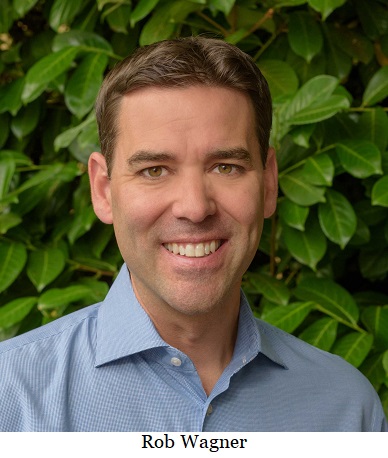
 has been the subject of hazing, harassment, and racist attacks at Lakeridge High School.
has been the subject of hazing, harassment, and racist attacks at Lakeridge High School.  plays on the junior varsity team. Her teammates have their
own social media accounts in which they ridicule, haze, and harass
plays on the junior varsity team. Her teammates have their
own social media accounts in which they ridicule, haze, and harass  . These teammates ostracize
. These teammates ostracize  . They have taken
. They have taken  photograph from games and edited into other photos where it appears that
photograph from games and edited into other photos where it appears that  is being harmed. These teammates have targeted to such a degree that is ostracized throughout campus and the school day.
is being harmed. These teammates have targeted to such a degree that is ostracized throughout campus and the school day.
 concerning similar hazing/harassing conduct. Principal Fisher did nothing to address this earlier complaint, which endorsed and condoned a hostile education environment. It was foreseeable that one term later, the same hazing and harassing conduct continued.
concerning similar hazing/harassing conduct. Principal Fisher did nothing to address this earlier complaint, which endorsed and condoned a hostile education environment. It was foreseeable that one term later, the same hazing and harassing conduct continued.
 program uses in hazing and harassing
program uses in hazing and harassing  .
.
 has begun self-injurious behavior as a result of the hazing, harassment, racism, negligence, and deliberate indifference endorsed and condoned by LOSD at Lakeridge High School.
has begun self-injurious behavior as a result of the hazing, harassment, racism, negligence, and deliberate indifference endorsed and condoned by LOSD at Lakeridge High School.


 Cortright outlines his prediction through what he dubs as the "7C's", Competition, Consumption, Couples, Careers, Creativity, Camaraderie, Commitment, and Civic Commons. "Those who work in the office will be better connected to the business, in the stream of more information; they’ll also be seen as having more commitment, and be able to discern the subtle cues (and bolster the in-person relationships) that privilege them over other workers. In short, those who work at a distance will be less competitive for pay, promotions, responsibility, and opportunity." Plainly stated those who aren't capable of working in person, will be left behind and suffer dramatic wage losses. In this new economic model of a post pandemic world, skill is not as important, as who is able to show up.
Cortright outlines his prediction through what he dubs as the "7C's", Competition, Consumption, Couples, Careers, Creativity, Camaraderie, Commitment, and Civic Commons. "Those who work in the office will be better connected to the business, in the stream of more information; they’ll also be seen as having more commitment, and be able to discern the subtle cues (and bolster the in-person relationships) that privilege them over other workers. In short, those who work at a distance will be less competitive for pay, promotions, responsibility, and opportunity." Plainly stated those who aren't capable of working in person, will be left behind and suffer dramatic wage losses. In this new economic model of a post pandemic world, skill is not as important, as who is able to show up.

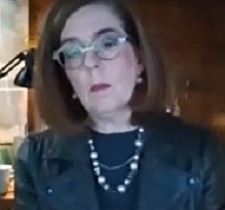
 In an open session of the Governor's Council of Economic Advisors, the Council addressed questions put to it by Governor.
In an open session of the Governor's Council of Economic Advisors, the Council addressed questions put to it by Governor.

